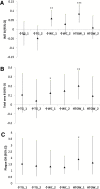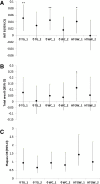The association between "hypertriglyceridemic waist" and sub-clinical atherosclerosis in a multiethnic population: a cross-sectional study
- PMID: 24558974
- PMCID: PMC3938067
- DOI: 10.1186/1476-511X-13-38
The association between "hypertriglyceridemic waist" and sub-clinical atherosclerosis in a multiethnic population: a cross-sectional study
Abstract
Background: "Hypertriglyceridemic waist" (HTGW) phenotype, an inexpensive early screening tool for detection of individuals at risk for type 2 diabetes and cardiovascular disease was found to be associated with subclinical atherosclerosis in various patient populations such as those with diabetes mellitus, chronic kidney disease, and those infected with human immunodeficiency virus. However, less is known regarding an association between HTGW and subclinical atherosclerosis in the apparently healthy, multiethnic population. Therefore, the aim of the study was to explore the association between HTGW and sub-clinical atherosclerosis in an apparently healthy, multiethnic population; and to investigate whether the effect of HTGW on sub-clinical atherosclerosis persists over and above the traditional atherosclerosis risk factors.
Methods: We studied 809 individuals of Aboriginal, Chinese, European and South Asian origin who were assessed for indices of sub-clinical atherosclerosis (intima-media thickness (IMT), total area and presence of carotid plaques), socio-demographic and lifestyle characteristics, anthropometrics, lipids, glucose, blood pressure, and family history of cardiovascular disease.
Results: We found that, compared to individuals without HTGW and after adjusting for age, ethnicity, smoking, and physical activity; men and women with HTGW had a significantly higher: IMT (men: B (95%CI = 0.084 (0.037, 1.133), p < 0.001; women: B (95%CI) = 0.041 (0.006, 0.077), p = 0.020); and total area (men: B (95%CI = 0.202 (0.058, 0.366), p = 0.005; women: B (95%CI) = 0.115 (0.006, 0.235), p = 0.037). The association between HTGW waist and presence of plaques was significant for men (OR (95%CI) = 1.904 (1.040, 3.486), p = 0.037 vs. men without HTGW), but not for women (p = 0.284). Once analyses were adjusted for additional, traditional risk factors for atherosclerosis, the effect of HTGW on sub-clinical atherosclerosis was no longer significant.
Conclusions: In conclusion, HTGW may serve as an early marker of subclinical atherosclerosis in men and women, irrespective of ethnicity. However, once individuals are assessed for all traditional risk factors for atherosclerosis, the additional assessment for HTGW is not warranted.
Figures


Similar articles
-
Association of "hypertriglyceridemic waist" with increased 5-year risk of subclinical atherosclerosis in a multi-ethnic population: a prospective cohort study.BMC Cardiovasc Disord. 2021 Feb 2;21(1):63. doi: 10.1186/s12872-021-01882-1. BMC Cardiovasc Disord. 2021. PMID: 33530949 Free PMC article.
-
The hypertriglyceridemic-waist phenotype is associated with the Framingham risk score and subclinical atherosclerosis in Canadian Cree.Nutr Metab Cardiovasc Dis. 2015 Nov;25(11):1050-5. doi: 10.1016/j.numecd.2015.09.004. Epub 2015 Sep 25. Nutr Metab Cardiovasc Dis. 2015. PMID: 26474723
-
[Hypertriglyceridemic waist phenotype is a risk factor for subclinical atherosclerosis in human immunodeficiency virus-infected patients].Med Clin (Barc). 2012 Dec 1;139(13):561-5. doi: 10.1016/j.medcli.2012.03.037. Epub 2012 Sep 15. Med Clin (Barc). 2012. PMID: 22985869 Spanish.
-
The association between the hypertriglyceridaemia waist phenotype, cardiovascular risk factors and the metabolic syndrome in South African Asian-Indians.Diabetes Metab Syndr. 2022 Jun;16(6):102524. doi: 10.1016/j.dsx.2022.102524. Epub 2022 May 27. Diabetes Metab Syndr. 2022. PMID: 35660930
-
Is an appropriate cutoff of hypertriglyceridemic waist designated for type 2 diabetes among Chinese adults?Clin Nutr. 2010 Apr;29(2):192-8. doi: 10.1016/j.clnu.2009.06.008. Epub 2010 Feb 12. Clin Nutr. 2010. PMID: 20153095
Cited by
-
Hypertriglyceridemic Waist: A Simple Marker of High-Risk Atherosclerosis Features Associated With Excess Visceral Adiposity/Ectopic Fat.J Am Heart Assoc. 2018 Apr 13;7(8):e008139. doi: 10.1161/JAHA.117.008139. J Am Heart Assoc. 2018. PMID: 29654193 Free PMC article.
-
Hypertriglyceridemic Waist Phenotype and Its Association with Metabolic Syndrome Components, among Greek Children with Excess Body Weight.Metabolites. 2023 Feb 3;13(2):230. doi: 10.3390/metabo13020230. Metabolites. 2023. PMID: 36837848 Free PMC article.
-
Genome- and epigenome-wide association study of hypertriglyceridemic waist in Mexican American families.Clin Epigenetics. 2016 Jan 20;8:6. doi: 10.1186/s13148-016-0173-x. eCollection 2016. Clin Epigenetics. 2016. PMID: 26798409 Free PMC article.
-
Predictors of metabolic abnormalities in phenotypes that combined anthropometric indices and triglycerides.BMC Complement Altern Med. 2016 Feb 10;16:59. doi: 10.1186/s12906-016-1024-1. BMC Complement Altern Med. 2016. PMID: 26861162 Free PMC article.
-
Prevalence and clinical characteristics of metabolically healthy obese individuals and other obese/non-obese metabolic phenotypes in a working population: results from the Icaria study.BMC Public Health. 2016 Apr 1;16:248. doi: 10.1186/s12889-016-2921-4. BMC Public Health. 2016. PMID: 27036105 Free PMC article.
References
-
- O’Leary DH, Polak JF, Kronmal RA, Manolio TA, Burke GL, Wolfson SK Jr. Carotid-artery intima and media thickness as a risk factor for myocardial infarction and stroke in older adults. Cardiovasc Health Study Collaborative Res Group NEJM. 1999;340:14–22. - PubMed
MeSH terms
LinkOut - more resources
Full Text Sources
Other Literature Sources
Medical

